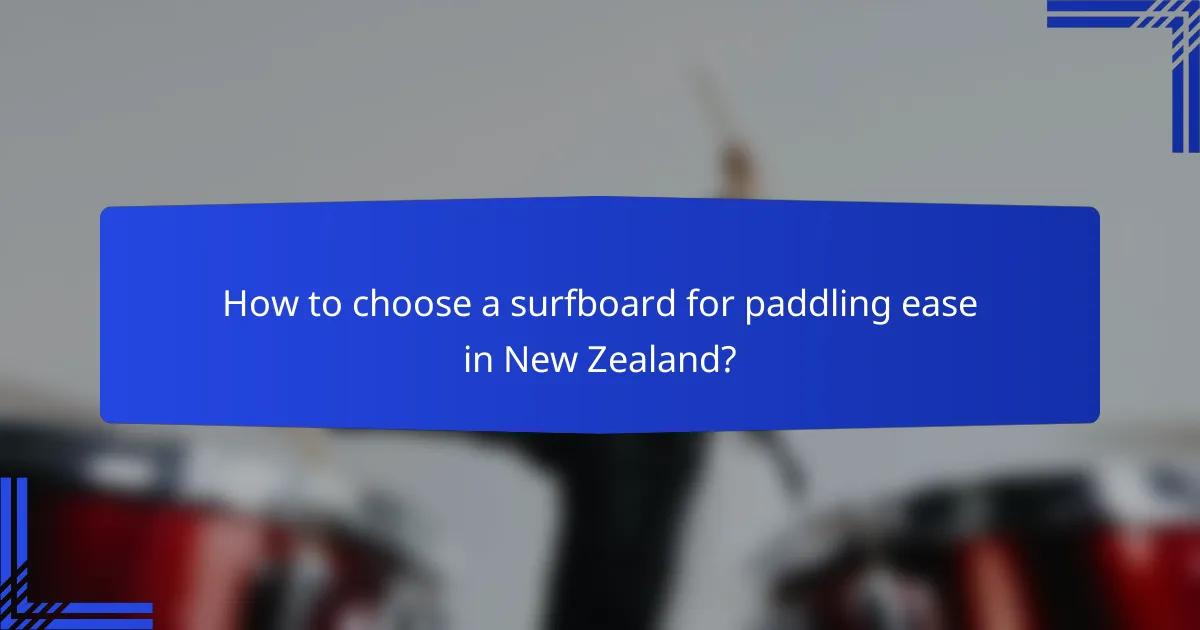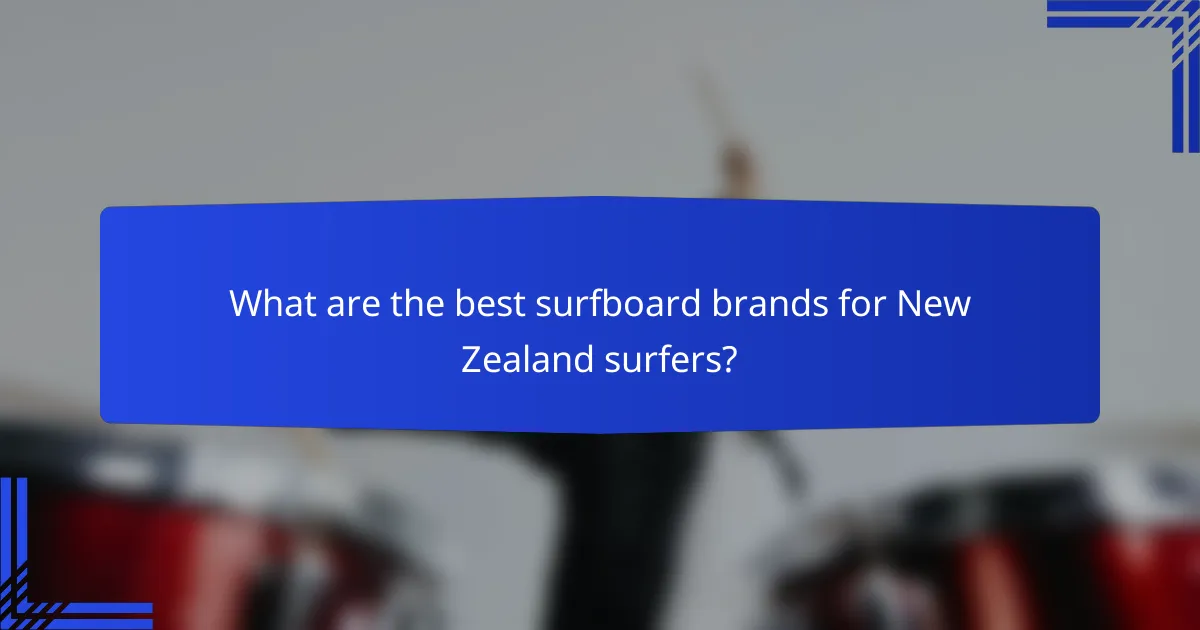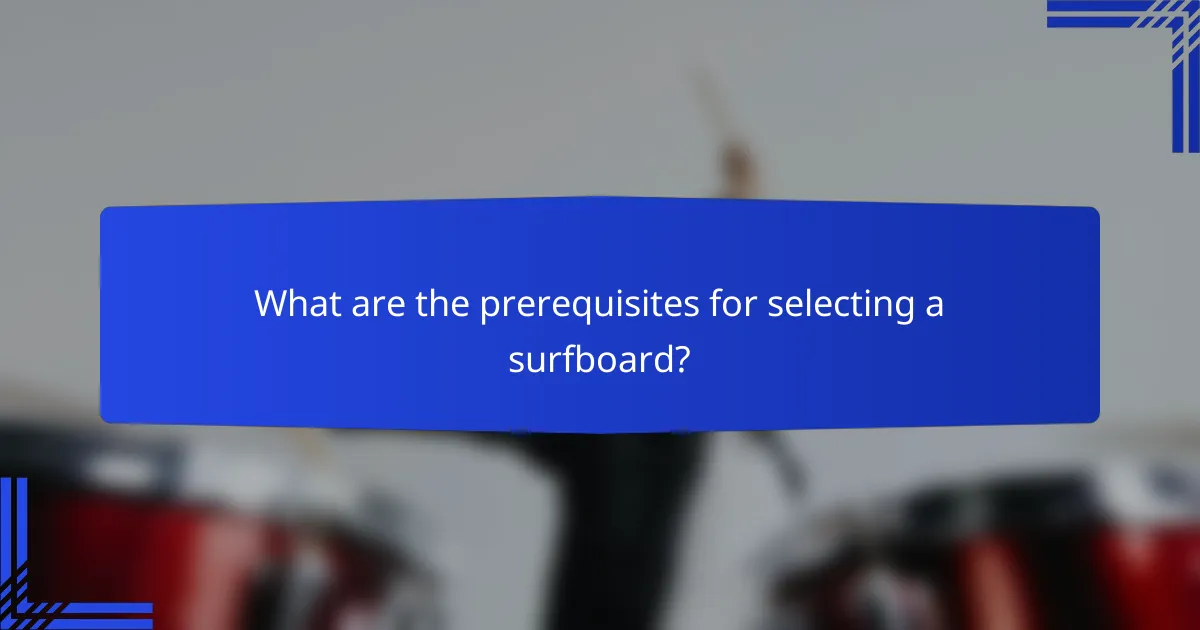Choosing the right surfboard involves understanding its paddling ease, wave catching capabilities, and maneuverability. Factors such as length, width, and volume play crucial roles in how easily a surfer can paddle and catch waves. Additionally, the board’s design influences its ability to turn and navigate, making it essential to select a board that aligns with your surfing style and the conditions you’ll encounter.

How to choose a surfboard for paddling ease in New Zealand?
To choose a surfboard that offers paddling ease in New Zealand, consider the board’s length, width, and volume. Longer and wider boards generally provide better stability and easier paddling, making them ideal for catching waves in various conditions.
Longboards for stability
Longboards are typically 9 feet or longer and are designed for stability, making them excellent for paddling ease. Their larger surface area allows for better buoyancy, which helps surfers catch waves with less effort.
In New Zealand’s diverse surf conditions, longboards can be particularly advantageous, especially in smaller, slower waves. They allow for smooth rides and are great for beginners and those looking to enjoy a leisurely surf experience.
Soft-top surfboards for beginners
Soft-top surfboards are ideal for beginners due to their forgiving construction and enhanced safety. These boards are usually wider and thicker, providing extra stability and buoyancy, which aids in paddling and wave catching.
In New Zealand, many surf schools recommend soft-tops for first-time surfers. They are less likely to cause injury during falls and allow new surfers to focus on developing their skills without the intimidation of harder boards.
Performance shortboards for advanced surfers
Performance shortboards are designed for advanced surfers who prioritize maneuverability over paddling ease. Typically ranging from 5 to 6.5 feet, these boards are narrower and have less volume, making them less stable but more responsive in the water.
While they require more skill to paddle effectively, experienced surfers in New Zealand often prefer shortboards for their ability to perform sharp turns and catch fast waves. It’s crucial for advanced surfers to choose a shortboard that matches their style and the specific wave conditions they encounter.

What features enhance wave catching ability?
Key features that enhance a surfboard’s wave catching ability include board volume, buoyancy, tail shape, and rocker profile. These elements work together to improve how easily a surfer can paddle into waves and maintain speed once they catch them.
Board volume and buoyancy
Board volume refers to the amount of space a surfboard occupies, which directly influences its buoyancy. A board with higher volume tends to float better, making it easier to paddle and catch waves, especially for beginners or heavier surfers.
When selecting a board, consider your weight and skill level. For instance, a volume range of 30 to 40 liters is often suitable for intermediate surfers weighing around 70 to 90 kg, while beginners may benefit from boards with even more volume to aid in stability and wave catching.
Tail shape and rocker profile
The tail shape of a surfboard affects how it interacts with the water, influencing maneuverability and speed. A wider tail can provide more lift, helping surfers catch waves more easily, while a narrower tail allows for sharper turns and quicker maneuvers once on the wave.
Rocker profile, or the curve of the board from nose to tail, also plays a crucial role. A board with a more pronounced rocker can help with turning and navigating steep waves, but may require more effort to paddle. A flatter rocker is beneficial for speed and ease of paddling, making it easier to catch waves.

How does surfboard maneuverability vary by type?
Maneuverability in surfboards varies significantly by type, affecting how easily a surfer can turn and navigate waves. Different designs cater to specific surfing styles and conditions, impacting performance and control.
Shortboards for quick turns
Shortboards are designed for agility and quick turns, making them ideal for experienced surfers looking to perform advanced maneuvers. Typically ranging from 5 to 7 feet in length, these boards have a narrow profile and a pointed nose, which allows for sharp, responsive movements.
When using a shortboard, surfers should focus on weight distribution and foot placement to maximize maneuverability. Quick transitions and tight arcs are possible, but this type of board requires good paddling skills and wave selection to be effective.
Fish boards for speed
Fish boards are characterized by their wider tails and shorter lengths, usually between 5 and 6.5 feet, which enhance speed and stability. These boards excel in smaller, less powerful waves, allowing surfers to maintain momentum while making smoother turns.
While fish boards may not turn as sharply as shortboards, they offer a unique combination of speed and ease of paddling. Surfers should consider using a fish board in conditions where quick acceleration is beneficial, but they may sacrifice some maneuverability compared to shorter, more agile boards.

What are the best surfboard brands for New Zealand surfers?
New Zealand surfers often prefer brands that combine quality craftsmanship with performance suited to local conditions. Key brands include Channel Islands, Lost, and Firewire, each offering unique features that cater to various surfing styles and skill levels.
Channel Islands Surfboards
Channel Islands Surfboards are renowned for their high-performance designs, making them a favorite among competitive surfers in New Zealand. Their boards are crafted with advanced materials, ensuring durability and responsiveness in various wave conditions.
When choosing a Channel Islands board, consider your skill level and the type of waves you typically surf. Models like the “Rocket Wide” are excellent for catching smaller waves, while the “Fish” series excels in maneuverability and speed.
Lost Surfboards
Lost Surfboards are celebrated for their innovative shapes and versatility, appealing to a wide range of surfers in New Zealand. They focus on creating boards that enhance paddling ease and wave-catching ability, which is crucial for local surf spots.
Popular models such as the “Puddle Jumper” are designed for fun, easy riding, making them suitable for both beginners and experienced surfers looking for a playful experience. Always consider the board’s volume and dimensions to match your weight and skill level.
Firewire Surfboards
Firewire Surfboards are known for their eco-friendly construction and cutting-edge technology, appealing to environmentally conscious surfers in New Zealand. Their boards often feature a unique flex pattern that enhances performance and maneuverability.
Models like the “Dominator” are ideal for various wave conditions, providing excellent paddle power and stability. When selecting a Firewire board, pay attention to the specific materials used, as they can significantly impact performance and longevity.

What are the prerequisites for selecting a surfboard?
Choosing the right surfboard involves understanding your skill level and the wave conditions you’ll be surfing in. These factors significantly influence paddling ease, wave catching ability, and maneuverability.
Skill level assessment
Your skill level is crucial when selecting a surfboard. Beginners typically benefit from wider, longer boards that provide stability and ease of paddling, while more advanced surfers might prefer shorter, more maneuverable boards that allow for tricks and sharper turns.
To assess your skill level, consider how comfortable you are with paddling, catching waves, and performing maneuvers. If you can consistently catch waves and perform basic turns, you might be ready to explore more specialized boards.
Wave conditions understanding
Understanding the wave conditions is essential for selecting a surfboard that suits your needs. Different boards perform better in varying wave sizes and types; for instance, a shorter board may excel in powerful, steep waves, while a longer board is better for smaller, slower waves.
Pay attention to local surf conditions, including wave height and frequency. For example, if you frequently surf in small beach breaks, a funboard or longboard may be ideal, while reef breaks may call for a shortboard. Always check local surf reports to gauge conditions before heading out.

How do surfboard dimensions affect performance?
Surfboard dimensions significantly influence performance aspects such as paddling ease, wave catching ability, and maneuverability. Understanding how length, width, thickness, and volume interact can help surfers choose the right board for their skill level and surfing style.
Length and width impact
The length and width of a surfboard directly affect its stability and speed. Longer boards typically provide better paddling ease and glide, making them ideal for beginners or for catching small waves. In contrast, shorter boards enhance maneuverability, allowing experienced surfers to perform tricks and turns more effectively.
Width plays a crucial role in stability; wider boards offer more surface area, which helps maintain balance, especially for novice surfers. However, a wider board may sacrifice some speed and responsiveness, making it less suitable for advanced maneuvers.
Thickness and volume considerations
Thickness and volume are key factors in determining how buoyant a surfboard is. Thicker boards generally have more volume, which aids in paddling and wave catching, making them suitable for heavier surfers or those who prefer a more stable ride. A board with higher volume can float better, allowing for easier entry into waves.
On the other hand, thinner boards provide less volume, which can enhance performance in terms of speed and responsiveness. However, they may require more skill to paddle and catch waves effectively. Surfers should consider their weight and skill level when selecting the appropriate thickness and volume for their boards.

What are the emerging trends in surfboard design?
Emerging trends in surfboard design focus on enhancing performance through innovative materials, shapes, and technologies. These advancements aim to improve paddling ease, wave catching ability, and maneuverability, catering to both beginners and experienced surfers.
Paddling Ease
Paddling ease is crucial for surfers, especially when catching waves. Modern surfboards often incorporate lightweight materials, such as epoxy and carbon fiber, which reduce the overall weight and enhance buoyancy. This allows for easier paddling and quicker positioning in the water.
Additionally, board shapes are evolving to feature wider noses and flatter rocker profiles, which help surfers paddle more efficiently. A wider nose provides more surface area, allowing for better stability and easier entry into waves.
Wave Catching
Wave catching capabilities are being improved through design innovations that enhance speed and responsiveness. Boards are now designed with increased volume in the tail area, which helps surfers gain momentum quickly as they approach a wave. This is particularly beneficial for beginners who may struggle with timing.
Another trend is the use of advanced fin systems that allow for customization based on wave conditions. Adjustable fin setups can optimize performance for different types of waves, making it easier to catch and ride them effectively.
Maneuverability
Maneuverability is a key factor for surfers looking to perform tricks and turns. Recent designs emphasize narrower tails and more pronounced rocker, which facilitate quick turns and agile movements on the wave. These features allow surfers to respond swiftly to changing wave dynamics.
Moreover, the integration of technology, such as 3D printing, enables the creation of unique board shapes that enhance performance. Customization options are becoming more accessible, allowing surfers to tailor their boards to their specific style and preferences.
